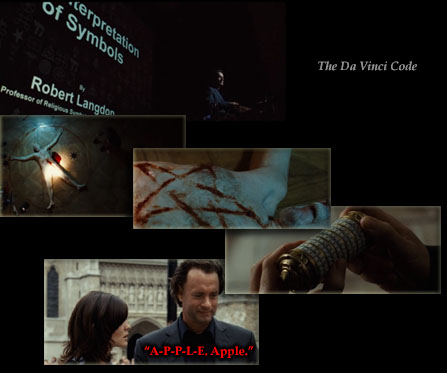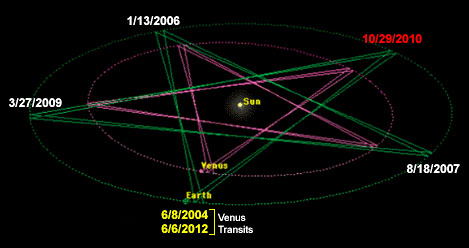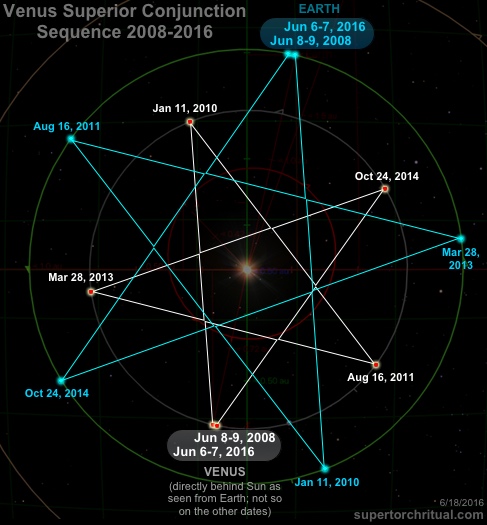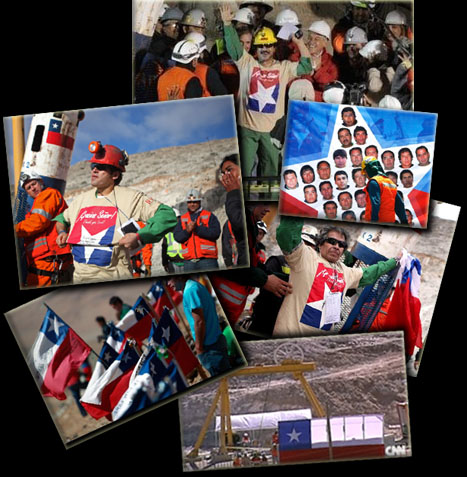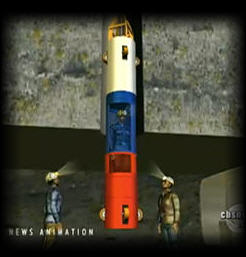 Primer
Primer
 Anterior
2 a 10 de 10
Següent
Anterior
2 a 10 de 10
Següent
 Darrer
Darrer

|
|
|
Astro Bob: See Venus at its most brilliant this week
"Astro" Bob King is a freelance writer for the News Tribune. Read more of his work at astrobob.areavoices.com.

The light of the crescent moon (left) and Venus is softened by high clouds on April 26 at dusk. (Bob King, for the News Tribune)
By Bob King, for the News Tribune
April 28, 2020 at 10:52 AM
Venus always looks bright, right? Well, yes and no. Its brightness varies with its phase and distance from the Earth. The planet is faintest when located on the opposite side of the sun from the Earth. Ironically, that’s also when it’s in “full moon” phase. But because it’s so far away at that time the Full Venus is tiny and about three times fainter than when it’s a crescent. At crescent phase the planet is much closer to the Earth (see diagram below).
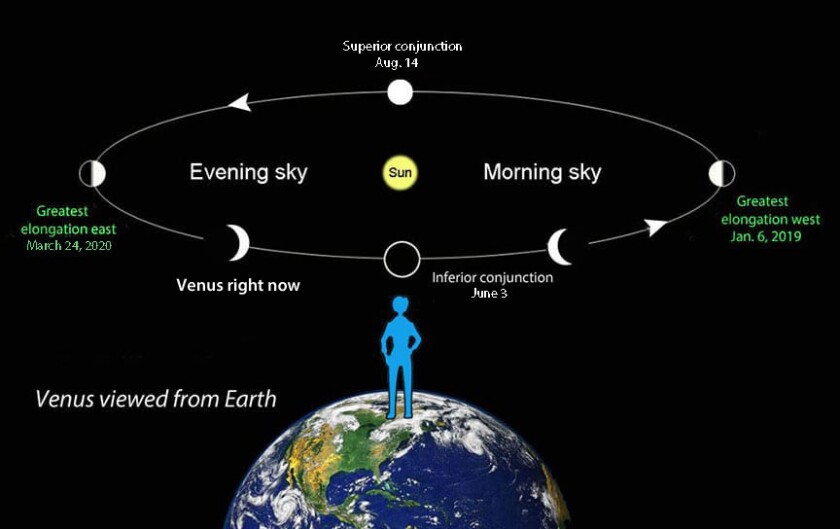
As Venus cycles around the sun very 225 days, it passes between the Earth and sun at inferior conjunction and on the opposite side of the sun in superior conjunction, when it looks like a tiny full moon. During this time, the changing angle the planet makes with the sun causes it show phases just like the moon. (Bob King, for the News Tribune)
On Monday night, April 27th Venus achieved greatest brilliancy at magnitude –4.7, the same brightness of a day-old moon if you could scrunch it down into a point of light. Greatest brilliancy strikes a balance between the size of the planet and how much of it is illuminated. Venus is brightest when relatively near the Earth at the same time it’s a thick crescent. While the planet will continue to approach the Earth in the coming weeks its crescent will enlarge but also thin. With less area illuminated by sunlight Venus will fade slightly.

Venus through a small telescope. The planet is a 26 percent-illuminated crescent and shines at greatest brilliancy this week. (Photo courtesy of Stellarium)
You can see the planet’s phase easily in any telescope or spotting scope. Skywatchers with 10x binoculars should also be able to discern the crescent during early dusk when the still-blue sky tempers its glare.
Why is Venus so darn bright in the first place? In a word — clouds. Overcast skies have been the rule across the planet for probably millions of years. While clouds keep the planet’s surface in perpetual gloom the view from this side is nothing short of amazing. Sunlight reflected off that cloud cover is responsible for Venus’s brilliance.
Earthly clouds are made of droplets or crystals of water but Venusian clouds are composed of toxic sulfuric acid droplets and sulfur dioxide. We see the planet’s upper cloud deck some 37-43 miles 60-70 km above the surface, about 3-4 times the altitude of high cirrus clouds on Earth. The planet’s water boiled off long ago, leaving sulfur dioxide from past (and possibly present) volcanic eruptions as the source of its clouds.
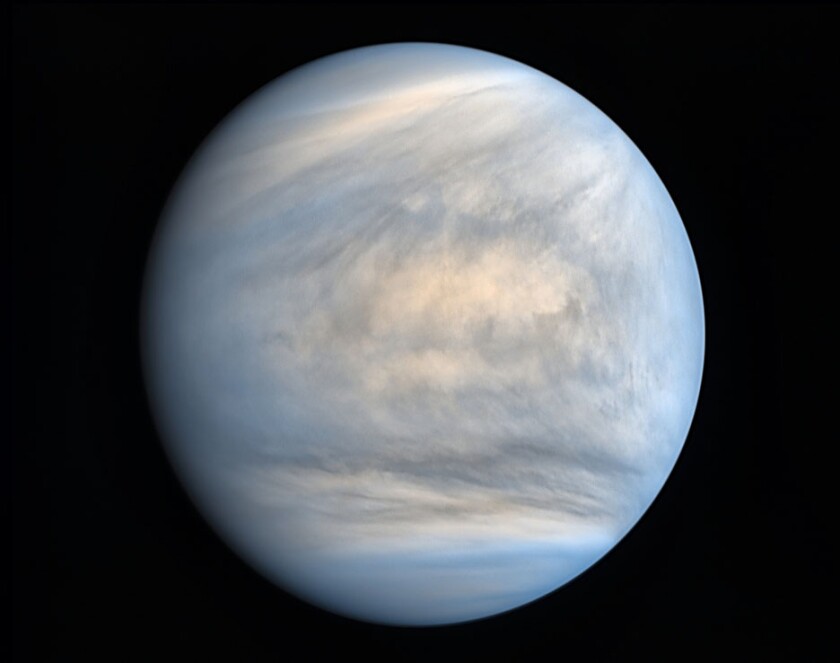
Japan’s Akatsuki probe took this global photo of Venus in ultraviolet light. In regular light the clouds are essentially featureless but in UV they reveal texture and structure. The dark streaks are some of the unknown UV absorbers (see below). JAXA / ISAS / DARTS / Damia-Bouic
Although Venus spins very slowly, taking 243 to turn once on its axis, the upper clouds rotate around the planet once every four Earth days. The planet’s atmosphere is composed of 96.5 percent carbon dioxide which combines forces with sulfur dioxide to trap heat and drive up the surface temperature to 864° F (462° C). Not what you’d call friendly to life.
But at the height of the clouds the temperature is much like that at the surface of the Earth making Venus’s upper atmosphere one of the most potentially habitable locales in the solar system. Even the late Carl Sagan considered the possibility that they might harbor vast colonies of bacteria. In a 1963 paper he hypothesized that the dark patches seen in ultraviolet light photographs of the planet called “ unknown UV absorbers ” could be made of bacteria that absorbed the light. Exactly what the dark splotches are remains a mystery to this day.
Mystery. Now there’s a fine word. It’s mystery that fuels curiosity and the urge to seek answers to our questions. Mystery is at the heart of everything. Nature is forever handing out business cards inviting us to “call”. I hope you call on Venus tonight.
https://www.duluthnewstribune.com/news/astro-bob-see-venus-at-its-most-brilliant-this-week |
|
|
|
|
Learn about Venus's weird transit cycle.
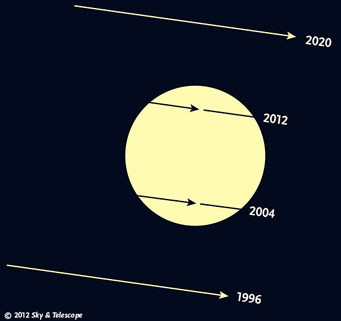
Venus took these tracks across the Sun in 2004 and 2012. Earth missed seeing a transit in 1996, and will miss another in 2020.
S&T: Gregg Dinderman
People attuned to the rhythms of the night sky know that certain cycles in astronomy repeat themselves over and over. These include the annual seasonal cycle as Earth orbits the Sun, the 29½-day cycle of lunar phases, and the fact that Mars comes to opposition every 26 months. Even solar and lunar eclipses come in saros cycles.
But compared to these other cycles, the current cycle for transits of Venus is weird. Make that really weird. This article explains why transits of Venus are so rare that the transit coming up on June 5th/6th will be the last one you'll ever see, why the cycle has such an odd pattern, and why the current cycle won't last forever. (The transit occurs on June 5th in the Western Hemisphere and June 6th in the Eastern Hemisphere.)
How to Get a Transit of Venus
For a transit of Venus to occur, two events must occur simultaneously, and it's rare to have such perfect synchrony.

Transits of Venus can only occur when Venus passes between the Sun and Earth, a point on its orbit known as inferior conjunction.
S&T
First, and most obvious, Venus has to move directly between Earth and the Sun so that an imaginary observer looking “down” on the solar system from above would see the three bodies form a perfectly straight line. When this happens, astronomers say that Venus has come to inferior conjunction. Venus orbits the Sun faster and in a smaller orbit, and it comes to these inferior conjunctions every 584 Earth days.
If Venus and Earth orbited the Sun in the same plane, we'd enjoy a transit of Venus every 584 days, and the June 5th transit wouldn't be such a big deal. But in reality, Venus's orbital plane is tipped 3.4 degrees relative to Earth's orbital plane. The planes cross each other at two points called nodes. To get a transit, Venus has to be at inferior conjunction at the exact same time it's at a node. This perfect 3-D lineup doesn't happen very often. Normally, Venus's inclined orbit means it is located “above” or “below” the Sun when it comes to inferior conjunction.

Venus's orbit around the Sun is inclined relative to Earth's orbit (exaggerated here for the sake of clarity). Transits of Venus can only occur at the two nodes, where the orbital planes of Venus and Earth intersect.
S&T: Gregg Dinderman
One of these nodes occurs in early June and the other in early December, meaning these are the only times that transits of Venus can occur. In early June, Venus appears to be diving “downward” (or south), so astronomers call this the descending node. In early December, Venus is moving “up” (or north) in its orbit, so this is an ascending node.
A Bizarre Cycle
So far, things probably seem rather simple and straightforward. But here's where the transit of Venus cycle starts getting weird (but also quite interesting).
For the past few centuries and the next few centuries, these perfect 3-D alignments occur at intervals of 8, 105½, 8, and 121½ years. In reality, think of this as a 243-year cycle, with pairs of transits separated by only 8 years, but with each pair separated by more than a century.
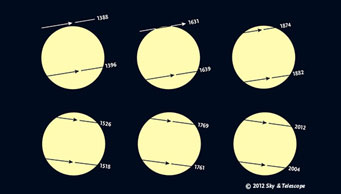
Venus tracks across the Sun are shown for years 1388 through 2012. The top row shows December transits at Venus's ascending node and the bottom row shows June transits at Venus's descending node.
S&T
Ascending-node transits occurred in December 1631, 1639, 1874, and 1882. The next ones occur in December 2117 and 2125. Descending-node transits occurred in June 1761, 1769, and 2004, with the next one coming June 5/6, 2012. After that, the next descending-node transits occur in June 2247 and 2255.
For the descending-node transits separated by 8 years, Venus crosses the southern part of the Sun's disk in the first transit, and the northern part the second time around. That's why Venus will cross the northern part of the Sun's disk on June 5th/6th. When Venus came to inferior conjunction in 1996, it was too far below the Sun to transit its disk. And in 2020, it will be too high.
The opposite is the case for ascending-node transits. The first transit in an 8-year pair crosses the northern part of the Sun, the second one crosses the southern half.
So why does Venus take “only” 105½ years to go from a pair of June transits to a pair of December transits, whereas it takes 121½ years to go from a pair of December transits to a pair of June transits? This asymmetry is due to the fact that Earth's orbit around the Sun is not quite a perfect circle. It's slightly elongated (the technical term is eccentric), deviating from a perfect circle by about 3 percent. In contrast, Venus's orbit is so close to being a perfect circle that its minuscule elongation can be ignored in this discussion.
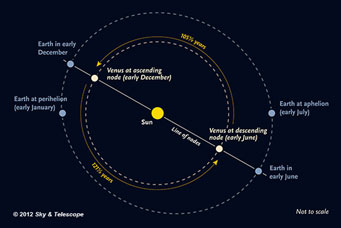
The Earth's elongated (eccentric) orbit (exaggerated in the diagram) explains why there is an asymmetry in the amount of time from one transit pair to the next.
S&T
The diagram on the right (in which Earth's orbital eccentricity is exaggerated for the sake of clarity) shows what's going on. Basically, Earth is near its farthest point from the Sun (aphelion) in June and near its closest point to the Sun (perihelion) in December. When Earth is closer to the Sun's powerful gravity, it moves slightly faster in its orbit than when it's farther from the Sun. The difference in Earth's orbital speed from perihelion to aphelion produces a longer gap (121½ years) between the time it takes to line up between the December and Junes transits than the 105½ years it takes to line up from the June to December transits.
Nothing Good Lasts Forever
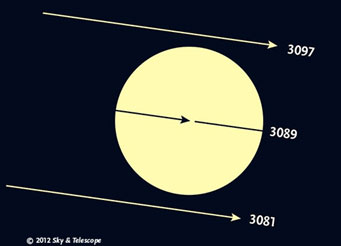
In the future, transits of Venus will become even more rare. This diagram shows the track Venus will take across the Sun in 3089. In 3081 and 3097, Venus's path will miss the Sun (from Earth's perspective).
S&T
Unfortunately for astronomers living in the distant future, the frequency of transits will decrease. Both Venus's and Earth's orbits precess, meaning they rotate over long time periods to produce a rosette-like pattern. In other words, Earth's perihelion shifts in its orbit, and so does Venus's. Because of precession, Earth-bound astronomers will only be able to enjoy one ascending-node transit for centuries after the year 3000. They will see a descending-node transit in 3089, but 8 years later, in 3097, Venus will come to inferior conjunction too far above the Sun to transit its disk.
And over tens of thousands of years, the 243-year cycle will eventually change as the eccentricity of Venus's and Earth's orbits evolve due to the gravitational perturbations of other planets. Over even longer timescales, chaotic effects take over, and the mathematics becomes so uncertain that today's astronomers can no longer predict when these rare celestial alignments will take place, and what future cycles will be like.
But for now, you can rest assured that there will be a transit of Venus on June 5th/6th, and unless modern medicine comes up with a miracle, this will be the last chance you'll ever have to see a transit of Venus from the surface of Earth.
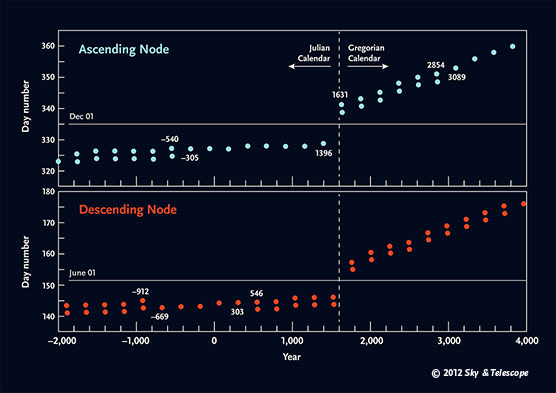
By plotting the number of days into each year when a transit of Venus occurs, it's easy to see the long-term behavior of transits of Venus, and the fact that we're fortunate to live during a period when we get to see two transits at both the ascending and descending nodes. Note the change from the Julian Calendar to the Gregorian Calendar around the year 1600. Retired NASA astronomer Fred Espenak provided S&T with the data for this diagram.
Courtesy Sky & Telescope
https://skyandtelescope.org/astronomy-news/observing-news/transits-of-venus-explained/ |
|
|
|
|
Aprenda sobre el extraño ciclo de tránsito de Venus.

Venus siguió estas trayectorias a través del Sol en 2004 y 2012. La Tierra no vio un tránsito en 1996 y no verá otro en 2020.
Ciencia y tecnología : Gregg Dinderman
Quienes conocen los ritmos del cielo nocturno saben que ciertos ciclos astronómicos se repiten una y otra vez. Estos incluyen el ciclo estacional anual de la Tierra en su órbita alrededor del Sol, el ciclo de 29 días y medio de las fases lunares y el hecho de que Marte entra en oposición cada 26 meses. Incluso los eclipses solares y lunares se producen en ciclos de saros.
Pero comparado con estos otros ciclos, el ciclo actual de tránsitos de Venus es extraño. ¡ De verdad, extraño! Este artículo explica por qué los tránsitos de Venus son tan raros que el que se producirá el 5 y 6 de junio será el último que verás, por qué el ciclo tiene un patrón tan peculiar y por qué el ciclo actual no durará para siempre. (El tránsito ocurre el 5 de junio en el hemisferio occidental y el 6 de junio en el hemisferio oriental).
Cómo obtener un tránsito de Venus
Para que se produzca un tránsito de Venus, deben ocurrir dos eventos simultáneamente, y es raro tener una sincronía tan perfecta.

Los tránsitos de Venus sólo pueden ocurrir cuando Venus pasa entre el Sol y la Tierra, un punto en su órbita conocido como conjunción inferior.
CALLE
En primer lugar, y lo más obvio, Venus debe moverse directamente entre la Tierra y el Sol para que un observador imaginario que mirase el sistema solar desde arriba vea los tres cuerpos formando una línea perfectamente recta. Cuando esto ocurre, los astrónomos dicen que Venus ha alcanzado una conjunción inferior . Venus orbita el Sol más rápido y en una órbita más pequeña, y alcanza estas conjunciones inferiores cada 584 días terrestres.
Si Venus y la Tierra orbitaran alrededor del Sol en el mismo plano, disfrutaríamos de un tránsito de Venus cada 584 días, y el tránsito del 5 de junio no sería tan importante. Pero en realidad, el plano orbital de Venus está inclinado 3,4 grados con respecto al plano orbital de la Tierra. Los planos se cruzan en dos puntos llamados nodos . Para que se produzca un tránsito, Venus debe estar en conjunción inferior al mismo tiempo que está en un nodo. Esta alineación tridimensional perfecta no ocurre muy a menudo. Normalmente, la órbita inclinada de Venus significa que se encuentra "encima" o "debajo" del Sol cuando se trata de conjunción inferior.

La órbita de Venus alrededor del Sol está inclinada respecto a la órbita de la Tierra (exagerada aquí para mayor claridad). Los tránsitos de Venus solo pueden ocurrir en los dos nodos, donde se intersecan los planos orbitales de Venus y la Tierra.
Ciencia y tecnología : Gregg Dinderman
Uno de estos nodos ocurre a principios de junio y el otro a principios de diciembre, lo que significa que estos son los únicos momentos en que pueden ocurrir tránsitos de Venus. A principios de junio, Venus parece estar descendiendo (o hacia el sur), por lo que los astrónomos lo llaman nodo descendente . A principios de diciembre, Venus se mueve hacia arriba (o hacia el norte) en su órbita, por lo que se trata de un nodo ascendente .
Un ciclo extraño
Hasta ahora, las cosas parecen bastante sencillas y directas. Pero aquí es donde el tránsito del ciclo de Venus empieza a volverse extraño (aunque también bastante interesante).
Durante los últimos siglos y los próximos, estas alineaciones tridimensionales perfectas se producen a intervalos de 8, 105½, 8 y 121½ años. En realidad, considérelo un ciclo de 243 años, con pares de tránsitos separados por tan solo 8 años, pero con cada par separado por más de un siglo.

Se muestran las trayectorias de Venus a través del Sol desde el año 1388 hasta el 2012. La fila superior muestra los tránsitos de diciembre en el nodo ascendente de Venus y la fila inferior muestra los tránsitos de junio en el nodo descendente de Venus.
CALLE
Los tránsitos de nodos ascendentes ocurrieron en diciembre de 1631, 1639, 1874 y 1882. Los siguientes tránsitos ocurrieron en diciembre de 2117 y 2125. Los tránsitos de nodos descendentes ocurrieron en junio de 1761, 1769 y 2004, y el siguiente tuvo lugar el 5 y 6 de junio de 2012. Posteriormente, los tránsitos de nodos descendentes ocurrieron en junio de 2247 y 2255.
En los tránsitos de nodos descendentes con una separación de 8 años, Venus cruza la parte sur del disco solar en el primer tránsito y la parte norte en el segundo. Por eso, Venus cruzará la parte norte del disco solar el 5 o 6 de junio. Cuando Venus llegó a la conjunción inferior en 1996, estaba demasiado por debajo del Sol para transitar su disco. Y en 2020, estará demasiado alto.
Lo contrario ocurre con los tránsitos de nodos ascendentes. El primer tránsito de un par de ocho años cruza la parte norte del Sol, mientras que el segundo cruza la mitad sur.
Entonces, ¿por qué Venus tarda “solo” 105 años y medio en pasar de un par de tránsitos de junio a un par de tránsitos de diciembre, mientras que tarda 121 años y medio en pasar de un par de tránsitos de diciembre a un par de tránsitos de junio? Esta asimetría se debe a que la órbita de la Tierra alrededor del Sol no es exactamente un círculo perfecto. Es ligeramente alargada (el término técnico es excéntrica ), desviándose de un círculo perfecto en aproximadamente un 3 %. En cambio, la órbita de Venus está tan cerca de ser un círculo perfecto que su minúscula elongación puede ignorarse en este análisis.

La órbita alargada (excéntrica) de la Tierra (exagerada en el diagrama) explica por qué hay una asimetría en la cantidad de tiempo entre un par de tránsitos y el siguiente.
CALLE
El diagrama de la derecha (en el que se exagera la excentricidad orbital de la Tierra para mayor claridad) muestra lo que está sucediendo. Básicamente, la Tierra está cerca de su punto más alejado del Sol ( afelio ) en junio y cerca de su punto más cercano al Sol ( perihelio ) en diciembre. Cuando la Tierra está más cerca de la poderosa gravedad del Sol, se mueve ligeramente más rápido en su órbita que cuando está más lejos del Sol. La diferencia en la velocidad orbital de la Tierra desde el perihelio hasta el afelio produce una brecha más larga (121½ años) entre el tiempo que tarda en alinearse entre los tránsitos de diciembre y junio que los 105½ años que tarda en alinearse entre los tránsitos de junio y diciembre.
Nada bueno dura para siempre

En el futuro, los tránsitos de Venus serán aún más raros. Este diagrama muestra la trayectoria que Venus seguirá frente al Sol en 3089. En 3081 y 3097, la trayectoria de Venus no tocará el Sol (desde la perspectiva terrestre).
CALLE
Desafortunadamente para los astrónomos que viven en un futuro lejano, la frecuencia de los tránsitos disminuirá. Tanto las órbitas de Venus como las de la Tierra precesan, lo que significa que giran durante largos períodos de tiempo para producir un patrón similar a una roseta. En otras palabras, el perihelio de la Tierra se desplaza en su órbita, al igual que el de Venus. Debido a la precesión, los astrónomos terrestres solo podrán disfrutar de un tránsito de nodo ascendente durante siglos después del año 3000. Verán un tránsito de nodo descendente en 3089, pero ocho años después, en 3097, Venus alcanzará una conjunción inferior demasiado por encima del Sol como para transitar su disco.
Y a lo largo de decenas de miles de años, el ciclo de 243 años acabará cambiando a medida que la excentricidad de las órbitas de Venus y la Tierra evolucione debido a las perturbaciones gravitacionales de otros planetas. En escalas de tiempo aún mayores, se imponen efectos caóticos, y las matemáticas se vuelven tan inciertas que los astrónomos actuales ya no pueden predecir cuándo ocurrirán estas raras alineaciones celestes ni cómo serán los ciclos futuros.
Pero por ahora, puedes estar seguro de que habrá un tránsito de Venus el 5 o 6 de junio y, a menos que la medicina moderna haga un milagro, esta será la última oportunidad que tendrás de ver un tránsito de Venus desde la superficie de la Tierra.

Al representar gráficamente el número de días de cada año en que ocurre un tránsito de Venus, es fácil observar su comportamiento a largo plazo y la suerte de vivir en un período en el que podemos observar dos tránsitos tanto en el nodo ascendente como en el descendente. Observe el cambio del calendario juliano al gregoriano alrededor del año 1600. El astrónomo jubilado de la NASA, Fred Espenak, proporcionó a S&T los datos para este diagrama.
Cortesía de Sky & Telescope
|
|
|
|
|
El pentagrama es una firma geométrica de Venus, lo que tiene mucho sentido en el contexto actual.
On June 5-6, 2012, a transit of Venus occurred, where Venus appeared as a small, dark spot passing across the face of the sun. This rare astronomical event happens in pairs, eight years apart, and is separated by 105 or 121 years. The transit began at 22:09 UTC on June 5, 2012, and ended at 04:49 UTC on June 6, 2012. The exact times varied by up to ±7 minutes depending on the observer's location.
|
|
|
|
|
"Occult Forms" Seen
An Addendum to
"When Venus Will Be Covered by the Sun"
(Orlando Massacre, Muhammad Ali, Hillary Clinton & Gotthard Base Tunnel)
By Goro Adachi
June 21, 2016

On June 12th, 2016, the deadliest mass shooting in US history took place at the "Pulse" gay nightclub in Orlando, Florida, where one crazed gunman killed 49 and injured many more in cold blood before getting fatally shot in a gunfight with a SWAT team. "As above, so below" was in full effect as this came only a few days after the Venus superior conjunction or "when Venus was covered by the Sun" discussed in my May 28 article " When Venus Will Be Covered by the Sun" in which I pinpointed late May-early June as a key window with a Nostradamian theme of "hidden/occult form" multicontextually represented by this image:
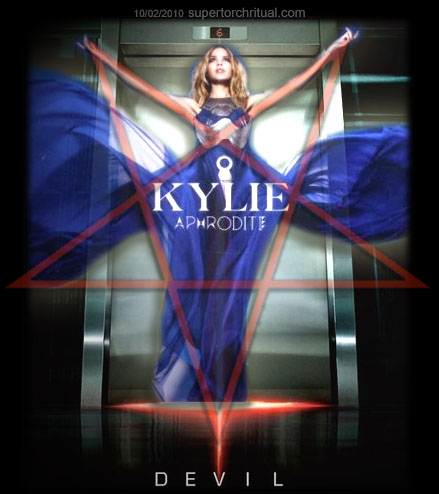
Century IV Quatrain 28
Lors que Venus du Sol sera couuert,
Soubs l'esplendeur sera forme occulte:
Mercure au feu les aura descouuert,
Par bruit bellique sera mis l'insulte.
When Venus will be covered by the Sun,
Under the splendor will be a hidden form:
Mercury will have exposed them to the fire,
Through warlike noise it will be insulted.
- NostradamusThough I did not explicitly state this, the image also expresses the idea of the "Birth of the Evening Star" (Venus) which happens to resonate strongly with the Orlando massacre. There are many aspect to the dark event, heavily interconnected with a few other major world events around the same time... The death/funeral of Muhammad Ali, June 3-10, was certainly another major "occult form" event, and this one is simpler to explain:
The name "Ali" means "elevated" as in "elevator"...

...underscored by Prince's death making big headlines the day before Ali's death. (Remember, Prince died in an elevator which he equated with the Devil.)
His first name is particularly telling as Muhammad happens to be a widely accepted meaning of "Baphomet". From Wikipedia:
Modern scholars such as Peter Partner and Malcolm Barber agree that the name of Baphomet was an Old French corruption of the name Muhammad, with the interpretation being that some of the Templars, through their long military occupation of the Outremer, had begun incorporating Islamic ideas into their belief system, and that this was seen and documented by the Inquisitors as heresy. [...]
Baphomet naturally screams "occult". Per my original article, the pentagrammic Sigil of Baphomet shown below is a very obvious and powerful "hidden/occult form".
Baphomet is also the "Sabbatic Goat"... just as Muhammad (Baphomet) Ali was a "GOAT" ("Greatest Of All Time)!


The timing of his death (June 3) was also undeniably pentagrammic in terms of Earth orbital geometry as you can see below, even connected to the earlier "Black-star death" of David Bowie. (Ali was obviously one of the world's biggest "black stars".)
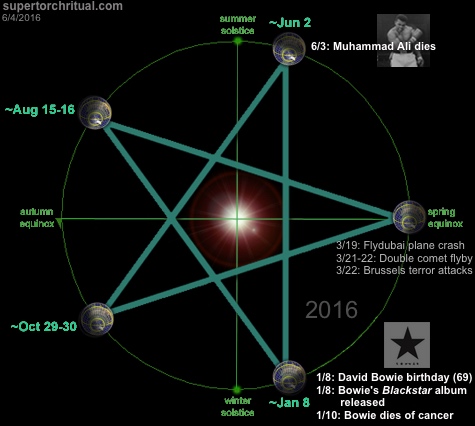
The pattern was foreseen as evidenced by the fact that over on STRUG I explicitly stated a major "black-star death"-type event might come "within 24 hours" the day before Ali's passing:
Jun 02 Death time (black pentagram star)[...] So there is actually good reason to suspect we may see something impactful within 24 hours, if not already... like Prince making big headlines again today (June 2), resonating with Bowie's "black-star" death... Monitoring... Ali was a heavyweight champion, which is symbolically significant for an existing pattern we've been following as "heavy" and "weight" together imply gravity. This echoes David Bowie's death which had "gravity" written all over it, foreshadowing the gravitational wave discovery announcement a month later. (See my article " Blackstar Shockwave".)

The detection of a second set of gravitational waves was revealed on June 15th, just days after Ali's funeral. All combined, Muhammad Ali's death was an unmistakable "occult form" event that came right on time.
* * *
Now back to the Orlando mass shooting (June 12)...
As noted earlier, this one came from a slightly different angle, with emphasis on the "Evening Star" and through which "orange"/"golden apple". To quickly summarize: Timing:
- The slightly "late" timing of the event (June 12) relative to the Venus superior conjunction ("covered by the sun") reflects the fact that it is after the conjunction that Venus becomes the "Evening Star" (it was the Morning Star prior to the conjunction)
- The event marked the anniversary of the O.J. Simpson murders (Nicole Brown & Ronald Goldman), highlighted this year by ESPN/ABC's well-received 5-part series O.J.: Made in America debuting on June 11
- "OJ" implies "orange juice" (OJ's nickname was "The Juice") which resonates with the following...
Golden apple (orange):
- In many languages "orange" = "golden apple"
- The Greeks called the Evening Star "Hesperus" whose daughters, the "Hesperides", tend the blissful garden where golden apples grew near the Atlas mountains (Greek mythology)
- The Orlando massacre happened on Orange Avenue in Orange County
- "Orlando" can mean "gold land" (or = "gold" in French); this also has relevance to California/LA which happens to be an important theme (we may get into that some other time)
- The Orlando massacre marked the anniversary of the O. J. Simpson murders (OJ = orange juice) in Los Angeles (sometimes called "The Big Orange")
A larger set of coincidences involving "Atlas", "elevator", etc. complements the emerging pattern:
- "Aphrodite" (Kylie's 2010 album title) is the Greek Venus
- Venus is traditionally associated with the pentagram
- After the June 6-7 superior conjunction, Venus is in its "Evening Star" phase
- The Greeks called the Evening Star "Hesperus"; in Greek mythology his daughters "Hesperides" tend the blissful garden where golden apples grew near the Atlas mountains
- Kylie is striking a "Atlas pose" on the Aphrodite cover
- "Atlas" (atl) can mean "elevator"
- Prince died in an elevator which he equated with the Devil
- Venus superior conjunction happened on Venus's "ascending node" (ascending = elevating = elevator)
- Venus superior conjunction was aligned with CERN LHC's ATLAS experiment (using decoding done in CERN's Orion Stargate)

In other words, Aphrodite/Venus, in the form of Kylie Minogue, coming out of the "Devil" elevator, whispered "birth of the Evening Star, temporally implying "after June 6-7, 2016"... matching the timing of the Orlando "orange"/"golden apple" massacre.   
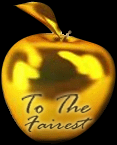
* * *
Hillary Clinton clinching the Democratic presidential nomination on June 6-7, precisely coinciding with the Venus superior conjunction, was another major event with an "occult form"...
 It had the Venus pentagram written all over it:
- The June 6-7 superior conjunction of Venus was an unusually precise one where Venus was directly behind the Sun as seen from Earth
- The previous such precise alignment was almost exactly 8 years ago on June 8-9, 2008
- It was right then on June 7, 2008, that Hillary Clinton endorsed Barack Obama and exited the presidential race
- 8 years - 2 days = how long it takes for Venus (and Earth) to complete a pentagram or "hidden/occult form" via orbital geometry (see graphic below). If you plot every successive Venus superior conjunction starting from June 8-9, 2008, you end up drawing a pair of near-perfect pentagrams ending on June 6-7, 2016, like this:
(Over on STRUG we were discussing this pattern already in March, so this is no hindsight stuff either.)
- Venus is the planet/goddess of love and the embodiment of femininity. Hillary Clinton is the first female major-party (presumptive) presidential nominee, clinching her nomination on a big Venus day.
* * *
For those who would like to see something more openly "occult" (oxymoron?), there was the grand opening of the world's longest tunnel in Switzerland on June 1st, just 2 days after Mars' closest approach to Earth.
After 17 years of construction and 28.2 million tons of excavated material, the world's longest and deepest rail tunnel has opened in Switzerland. And the ceremony featuring alphorn players, topless "angels" and goats, could not have been more bizarre.
Masked acrobats and interpretive dancers dressed like miners ushered in the Gotthard Base Tunnel's opening near the town of Erstfeld Wednesday.
Leaders from six countries attended the flashy ceremony, including German chancellor Angela Merkel and French President François Hollande. [...]
Among the performances was a topless dancer wearing giant wings who soared over orange-suited dancers as they crawled on the ground below.
At another point, humans dressed like bales of hay were seen swaying on a flatbed before running around on the floor.
Some of the scarier parts of the performance reportedly captured the area's "mountain demons" — which can be the storms, unidentified shapes and sounds, and falling objects, according to the tunnel's website.
The whole spectacle left many people on Twitter both amused and confused.
"Zombies" coming out of the "underworld" was also more or less what we saw at the Chilean mine rescue back on October 13, 2010... duly accompanied by inverted pentagrams...
This "ritual" in Chile, as I pointed out in my original article, coincided with Mars returning to the NASA Deep Impact-Comet Tempel 1 contact point (July 4, 2005)...
...which Mars was also doing right around June 1, 2016, precisely at the time of the Gotthard Base Tunnel opening ritual - once again showing "zombies"/"devils" coming out of the underground" - in Switzerland!

The pattern is quite compelling. So much so, we could/did see this coming.
* * *
So there you have it. All in all, what we saw was the Devil's in the details of dramatic world events; a set of pattern manifestations that were both dramatic and discrete. "As above, so below" is a powerful thing; if you can read the stars/patterns well enough, you can get glimpses of the future and insights into where we are in time. (For example, you might get the impact August coming up.) The less we are stuck in time, the more fully you can be in the present, because you'd be more in control of your own destiny. With a better map, you can better navigate the treacherous river of time. And we do need a good map especially in the 21st century, when time/history will end.
Want more rapid and in-depth updates? Jump to the...
https://www.goroadachi.com/etemenanki/occult_forms.html |
|
|
|
|
The result:

The orbit of Venus narrowly misses the center of the SPS.

Everything does click, however, when we…
- Rotate LHC/SPS diagram ~3.4 degrees counterclockwise
- Use the (slightly larger) Moon size instead of the SPS

Now the orbit of Venus passes right through the center of the lunar SPS…


And it is no random point on Venus's orbit: The lunar SPS center is specifically pinpointing Venus's "ascending node". That's where Venus crosses northward the plane of Earth's orbit (i.e. the ecliptic or the plane of the solar system)!
The ~3.4 degrees rotation actually makes perfect sense here because:
- The ascending node is all about the inclination of the orbit relative to the ecliptic or Earth's orbital plane…
- In the case of Venus, the orbital inclination is 3.4 degrees, matching the ~3.4 degree rotation required to bring the (lunar) SPS center to the Venus ascending node

Ascending nodes will play a critical role later on as well so we can be certain this is no coincidence.
The curious position of the SPS has now been perfectly explained.
Line of Nodes & Transit of Venus
The ascending node of Venus is aligned with the Galactic Meridian or "longitude 0" of the Milky Way (which passes through the Galactic Center and is perpendicular to the Milky Way/Galactic Equator).

The line is also heliocentrically aligned with Earth around June 8 and December 9 every year right when Earth's orbital position coincides with the LHC's ATLAS and CMS detectors.

From Earth's perspective, the Sun is at the Galactic Meridian on ~June 8 and ~December 9.

It's right there at the Sun's ~June 8 position that what astronomers call the Transit of Venus takes place, which is a very rare celestial event when Venus passes right in front of the Sun due to a very precise Earth-Venus-Sun alignment (accurate in 3D):
The most recent transit pair (they come in pairs) was in 2004 and 2012 (June 8 & June 6 respectively). The LHC went live in 2008 which was right at the halfway point, i.e. 4 years after the 1st Venus Transit and 4 years before the 2nd Venus Transit. (The previous Venus Transit pair was December 1874 and December 1882; the next pair will be December 10–11, 2117, and December 8, 2125.)

Jun 8, 2004 Planet Venus completes transit
That's enough evidence for us to safely conclude that the LHC was fully cognizant of what was happening in the sky.
Secret Design #3 - Mars-Mercury-Earth Orbital Interaction
Let us go deeper into the rabbit hole through… Mars. It is through Mars that we will finally flesh out the "Orion Stargate.
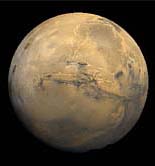 
What we'll do now is, instead of Earth's orbit, we'll use Mars' orbit as the celestial analogue of the LHC like this:

[Note: The LHC/SPS is still in its 3.4 deg.-rotated orientation]
While nothing seems to stand out initially, we do get our first confirmation after rotating the LHC so that the SPS would "kiss" Mars' perihelion i.e. Mars' closest point to the Sun (and to Earth's orbit), like this:

- Earth's orbit (green) passes right through the center of the SPS
- Earth's equinoctial axis (horizontal) is tangential to the SPS

Now we are ready for the main revelation which commences with the following observation…
|
|
|
|
|
Venus nodes refer to the points where Venus's orbital plane intersects Earth's orbital plane (the ecliptic). These points are crucial for transits of Venus, which occur when Venus passes in front of the Sun as seen from Earth. |
|
|
|
|
What Is a Transit of Venus?
A Venus transit is a phenomenon in which the disk of the planet Venus passes like a small shadow across the face of the Sun. The transit can be seen (with proper protection!) by the unaided eye and looks something like a moving sunspot. (Sunspots take about two weeks to cross the face of the Sun, however, while Venus takes a little over six hours). Among the rarest of astronomical events, Venus transits occur eight years apart—and then don’t happen again for more than a century. The last transit before 2004 took place in 1882.
Why Do We See the Transit from Earth?
Venus is the second planet from the Sun and Earth is the third, and the planets circle the Sun at different speeds. It happens from time to time that Venus comes between Earth and the Sun, an event called an inferior conjunction.
A top-down view would look like Fig. 1.
Why Do We See It So Rarely?
A Venus transit is similar to a solar eclipse, in which the face of the Sun is blocked by the Moon. But we don’t see a solar eclipse every time the Moon is between Earth and the Sun—which is every time there’s a new Moon. Similarly, we don’t see a transit of Venus every time Venus is between Earth and the Sun—which happens about every 584 days or 1.6 years. That’s because both Venus and the Moon, from our earthly point of view, can be above or below the Sun (Fig.2), and sunlight reaches us undisturbed.
The orbit of Venus around the Sun is tipped in relation to the orbit of Earth. As viewed from the Sun, the orbits cross at two points (called the nodes), and it is only at these points that the planets and the Sun line up directly (Fig.3).
A View of Venus' Orbit from the Moving Earth
This animation shows Venus from the perspective of the moving Earth. Here you see the position of Venus relative to Earth's orbit (the green line) in the few months leading up to June 8, 2004, and then watch as Venus transits the Sun on that date.
During the inferior conjunction of June 8, 2004, Venus is quite close to one of the nodes and is seen to transit the southern half of the Sun. Eight years later (June 5-6, 2012), during another inferior conjunction, Venus is near the same node. This time, the planet crosses the northern half of the Sun. After that, Venus won’t be near one of the nodes during a conjunction until 2117.
Why Is the Pattern of Transits So Irregular?
Venus and Earth come into conjunction every 583.92 days. After five conjunctions (583.92 days x 5 = 2919.6 days), approximately eight years have passed (365.25 x 8 = 2922 days). If the number of days were identical, during a conjunction Venus would be in exactly the same place that it was eight years previously. However, the difference of 2.4 days means that Venus comes close to its position of eight years earlier, but it’s not in the precise spot. And that makes all the difference as far as transits are concerned. (Fig. 4)
https://annex.exploratorium.edu/venus/question1.html |
|
|
 Primer
Primer
 Anterior
2 a 10 de 10
Següent
Anterior
2 a 10 de 10
Següent
 Darrer
Darrer

|




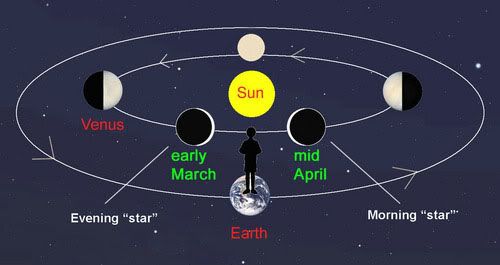

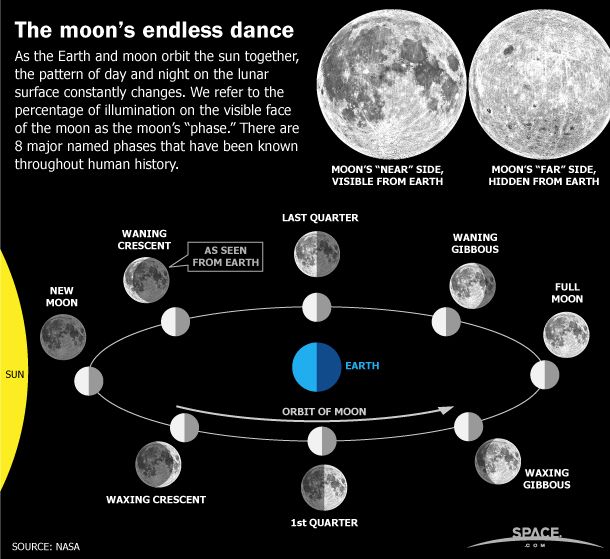


 6
6






